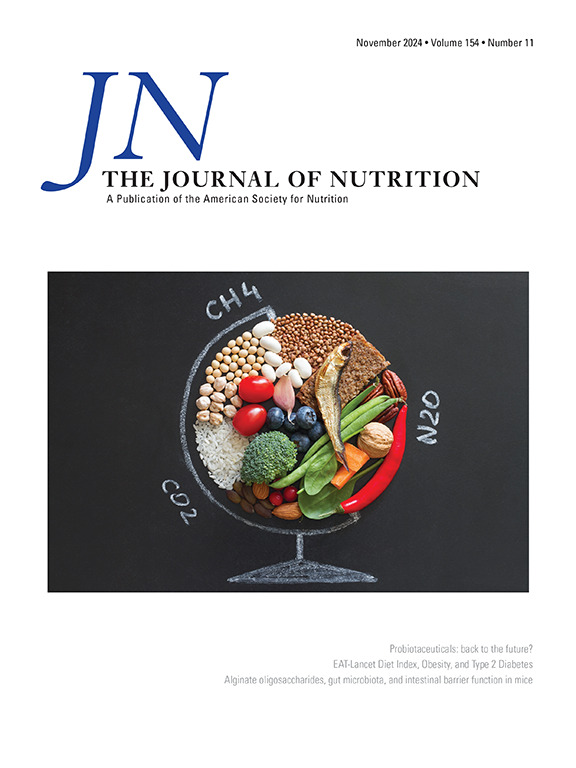The Association of Prenatal Dietary Factors with Child Autism Diagnosis and Autism-Related Traits Using a Mixtures Approach: Results from the Environmental Influences on Child Health Outcomes Cohort
IF 3.7
3区 医学
Q2 NUTRITION & DIETETICS
引用次数: 0
Abstract
Background
Previous research on the role of maternal diet in relation to autism has focused on examining individual nutrient associations. Few studies have examined associations with multiple nutrients using mixtures approaches, which may better reflect true exposure scenarios.
Objectives
This study aims to examine associations of nutrient mixtures with children’s autism diagnosis and trait scores within a large, diverse population.
Methods
Participants were drawn from the United States Environmental influences on Child Health Outcomes (ECHO) consortium. Maternal prenatal diet was reported via validated food frequency questionnaires. Children’s autism-related traits were measured using the Social Responsiveness Scale (SRS) and autism diagnoses were from parent reports of physician diagnosis. Bayesian kernel machine regression was used to examine the overall mixture effect and interactions between a set of 5 primary nutrients (folate, vitamin D, omega 3 and omega 6 fatty acids, and iron), adjusted for potential confounders, in relationship to child outcomes. Secondary analyses were conducted in a subset of cohorts with an expanded set of 14 nutrients. Traditional linear and logistic regression models were also analyzed for comparison of results to mixture models.
Results
A total of 2614 participants drawn from 7 ECHO cohorts were included in primary analysis. Mixture analyses suggested that increasing the overall 5-nutrient mixture was associated with lower SRS scores. Individual U-shaped associations and bivariate interactions between folate and omega 3 fatty acids were suggested. In the subset included in the secondary analyses of the 14-nutrient mixture, a modest inverse trend remained, but individual nutrient associations were altered, with vitamin D demonstrating higher relative importance than other nutrients. Strong associations with autism diagnosis were not observed.
Conclusions
In this large sample, we found evidence for combined nutrient effects with broader autism-related traits. Because results for individual nutrients were sensitive to mixture components, replication of combined associations between nutrients and autism-related outcomes is needed.
产前饮食因素与儿童自闭症诊断和自闭症相关特征的关联:来自ECHO队列的结果
背景:以往关于母亲饮食在自闭症中的作用的研究主要集中在检查个体营养关联。很少有研究使用混合方法检查与多种营养素的关系,这可能更好地反映真实的暴露情况。目的:在一个大的、不同的人群中,研究营养混合物与儿童自闭症诊断和特征评分的关系。方法:参与者来自美国环境对儿童健康结局的影响(ECHO)联盟。通过有效的食物频率问卷报告孕妇产前饮食。儿童孤独症相关特征采用社会反应量表(Social Responsiveness Scale, SRS)进行测量,孤独症诊断采用父母报告或医师诊断。贝叶斯核机回归(BKMR)用于检查五种主要营养素(叶酸、维生素D、欧米伽3和欧米伽6脂肪酸和铁)与儿童结局的总体混合效应和相互作用,并对潜在的混杂因素进行了调整。二次分析是在一组扩展了14种营养素的队列中进行的。还运行了传统的线性和逻辑回归模型,将结果与混合模型进行比较。结果:从7个ECHO队列中抽取2614名参与者纳入初步分析。混合分析表明,增加5种营养物质的总体混合与较低的SRS评分相关。叶酸和omega - 3脂肪酸之间的个体u形关联和双变量相互作用被提出。在对14种营养素混合物进行二次分析的子集中,仍然存在适度的反向趋势,但个别营养素的相关性发生了变化,维生素D显示出比其他营养素更高的相对重要性。没有观察到与自闭症诊断有很强的联系。结论:在这个大样本中,我们发现了营养影响与更广泛的自闭症相关特征相结合的证据。由于单个营养素的结果对混合成分很敏感,因此需要复制营养素与自闭症相关结果之间的综合关联。
本文章由计算机程序翻译,如有差异,请以英文原文为准。
求助全文
约1分钟内获得全文
求助全文
来源期刊

Journal of Nutrition
医学-营养学
CiteScore
7.60
自引率
4.80%
发文量
260
审稿时长
39 days
期刊介绍:
The Journal of Nutrition (JN/J Nutr) publishes peer-reviewed original research papers covering all aspects of experimental nutrition in humans and other animal species; special articles such as reviews and biographies of prominent nutrition scientists; and issues, opinions, and commentaries on controversial issues in nutrition. Supplements are frequently published to provide extended discussion of topics of special interest.
 求助内容:
求助内容: 应助结果提醒方式:
应助结果提醒方式:


